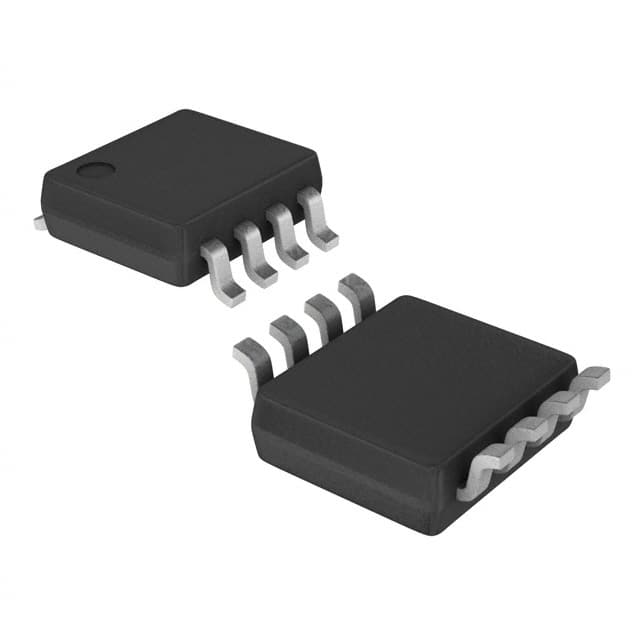INA2180A2IDGKT
Product Overview
Category: Integrated Circuit (IC)
Use: The INA2180A2IDGKT is a high-precision, low-power, bidirectional current-sensing IC. It is designed for use in various applications that require accurate current measurements, such as power management systems, battery chargers, motor control, and energy monitoring.
Characteristics: - High precision: The INA2180A2IDGKT offers excellent accuracy in current sensing, with a typical gain error of only ±0.5%. - Low power consumption: It operates at a low supply voltage range of 2.7V to 5.5V, making it suitable for battery-powered devices. - Bidirectional current sensing: The IC can measure both positive and negative currents flowing through the load. - Wide common-mode voltage range: It can handle common-mode voltages from -0.3V to +26V, allowing for versatile applications. - Small package size: The INA2180A2IDGKT comes in a compact MSOP-10 package, which makes it suitable for space-constrained designs.
Package and Quantity: The INA2180A2IDGKT is available in a MSOP-10 package. It is typically sold in reels of 2500 units.
Specifications
- Supply Voltage Range: 2.7V to 5.5V
- Gain Error: ±0.5%
- Common-Mode Voltage Range: -0.3V to +26V
- Operating Temperature Range: -40°C to +125°C
- Package Type: MSOP-10
Pin Configuration
The INA2180A2IDGKT has the following pin configuration:
___________
V+ | | OUT+
IN+ | | IN-
IN- | | OUT-
REF-| | V-
¯¯¯¯¯¯¯¯¯¯¯
Functional Features
- High accuracy current sensing: The INA2180A2IDGKT utilizes a precision amplifier and a high-precision shunt resistor to provide accurate current measurements.
- Bidirectional current measurement: It can measure both positive and negative currents flowing through the load, making it suitable for applications such as battery charging and motor control.
- Wide common-mode voltage range: The IC can handle a wide range of common-mode voltages, allowing for flexible use in various systems.
- Low power consumption: With its low supply voltage range and low quiescent current, the INA2180A2IDGKT minimizes power consumption, making it ideal for battery-powered devices.
Advantages and Disadvantages
Advantages: - High precision current sensing - Bidirectional current measurement capability - Wide common-mode voltage range - Low power consumption - Compact package size
Disadvantages: - Limited maximum common-mode voltage (up to +26V) - Requires an external shunt resistor for current sensing
Working Principles
The INA2180A2IDGKT works based on the principle of measuring the voltage drop across a shunt resistor to determine the current flowing through it. The IC amplifies this voltage drop and provides an output proportional to the current being measured. By utilizing a precision amplifier and a high-precision shunt resistor, it achieves high accuracy in current sensing.
Application Field Plans
The INA2180A2IDGKT finds applications in various fields, including:
- Power management systems: It can be used for precise current monitoring in power supplies, DC-DC converters, and voltage regulators.
- Battery chargers: The IC enables accurate current measurement during battery charging processes, ensuring optimal charging performance.
- Motor control: It can be employed in motor control systems to monitor the current flowing through the motor windings, enabling precise control and protection.
- Energy monitoring: The INA2180A2IDGKT is suitable for energy monitoring applications, allowing accurate measurement of power consumption in various devices and systems.
Alternative Models
- INA219: This IC offers similar functionality to the INA2180A2IDGKT but includes additional features such as voltage measurement and I2C interface.
- ACS712: A Hall effect-based current sensor that provides galvanic isolation and high immunity to noise.
- MAX4080: A precision high-side current-sense amplifier with a wide input common-mode range and low offset voltage.
These alternative models offer different features and specifications, providing options for specific application requirements.
Word count: 550 words
Senaraikan 10 soalan dan jawapan biasa yang berkaitan dengan aplikasi INA2180A2IDGKT dalam penyelesaian teknikal
Sure! Here are 10 common questions and answers related to the application of INA2180A2IDGKT in technical solutions:
Q: What is the INA2180A2IDGKT? A: The INA2180A2IDGKT is a high-precision, low-power, bidirectional current sense amplifier.
Q: What is the purpose of using the INA2180A2IDGKT in a technical solution? A: The INA2180A2IDGKT is used to accurately measure and monitor bidirectional current flow in various applications.
Q: What is the operating voltage range of the INA2180A2IDGKT? A: The INA2180A2IDGKT operates from a single supply voltage ranging from 2.7V to 5.5V.
Q: Can the INA2180A2IDGKT measure both positive and negative currents? A: Yes, the INA2180A2IDGKT can measure both positive and negative currents with its bidirectional current sensing capability.
Q: What is the maximum common-mode voltage range supported by the INA2180A2IDGKT? A: The INA2180A2IDGKT supports a wide common-mode voltage range of -16V to +80V.
Q: How accurate is the current measurement provided by the INA2180A2IDGKT? A: The INA2180A2IDGKT offers high accuracy with a typical gain error of only ±0.5% and a typical offset error of ±100µV.
Q: Can the INA2180A2IDGKT be used in high-frequency applications? A: Yes, the INA2180A2IDGKT has a bandwidth of 200kHz, making it suitable for high-frequency current sensing.
Q: Does the INA2180A2IDGKT provide any fault detection features? A: Yes, the INA2180A2IDGKT includes an overcurrent alert flag that can be used to detect and respond to fault conditions.
Q: Can multiple INA2180A2IDGKT amplifiers be used in parallel for higher current sensing capability? A: Yes, multiple INA2180A2IDGKT amplifiers can be connected in parallel to increase the overall current sensing range.
Q: What are some typical applications of the INA2180A2IDGKT? A: The INA2180A2IDGKT is commonly used in power management systems, battery monitoring, motor control, and industrial automation applications.
Please note that these answers are general and may vary depending on specific use cases and requirements.


